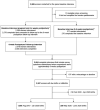Impact of the Early Stages of the COVID-19 Pandemic on Coverage of Reproductive, Maternal, and Newborn Health Interventions in Ethiopia: A Natural Experiment
- PMID: 35812521
- PMCID: PMC9260240
- DOI: 10.3389/fpubh.2022.778413
Impact of the Early Stages of the COVID-19 Pandemic on Coverage of Reproductive, Maternal, and Newborn Health Interventions in Ethiopia: A Natural Experiment
Abstract
Background: The COVID-19 pandemic and response have the potential to disrupt access and use of reproductive, maternal, and newborn health (RMNH) services. Numerous initiatives aim to gauge the indirect impact of COVID-19 on RMNH.
Methods: We assessed the impact of COVID-19 on RMNH coverage in the early stages of the pandemic using panel survey data from PMA-Ethiopia. Enrolled pregnant women were surveyed 6-weeks post-birth. We compared the odds of service receipt, coverage of RMNCH service indicators, and health outcomes within the cohort of women who gave birth prior to the pandemic and the COVID-19 affected cohort. We calculated impacts nationally and by urbanicity.
Results: This dataset shows little disruption of RMNH services in Ethiopia in the initial months of the pandemic. There were no significant reductions in women seeking health services or the content of services they received for either preventative or curative interventions. In rural areas, a greater proportion of women in the COVID-19 affected cohort sought care for peripartum complications, ANC, PNC, and care for sick newborns. Significant reductions in coverage of BCG vaccination and chlorohexidine use in urban areas were observed in the COVID-19 affected cohort. An increased proportion of women in Addis Ababa reported postpartum family planning in the COVID-19 affected cohort. Despite the lack of evidence of reduced health services, the data suggest increased stillbirths in the COVID-19 affected cohort.
Discussion: The government of Ethiopia's response to control the COVID-19 pandemic and ensure continuity of essential health services appears to have successfully averted most negative impacts on maternal and neonatal care. This analysis cannot address the later effects of the pandemic and may not capture more acute or geographically isolated reductions in coverage. Continued efforts are needed to ensure that essential health services are maintained and even strengthened to prevent indirect loss of life.
Keywords: COVID-19; Ethiopia; intervention coverage; maternal health; newborn health.
Copyright © 2022 Carter, Zimmerman, Qian, Roberton, Seme and Shiferaw.
Conflict of interest statement
The authors declare that the research was conducted in the absence of any commercial or financial relationships that could be construed as a potential conflict of interest.
Figures

References
-
- COVID-19 Map—Johns Hopkins Coronavirus Resource Center . (2020). Available online at: https://coronavirus.jhu.edu/map.html (accessed November 3, 2020).
-
- PATH . RMNCAYH-N Services During COVID-19: A Spotlight on Ethiopia's Policy Responses to Maintain and Adapt Essential Health Services. (2021). Seattle WA: PATH. Available online at: https://path.azureedge.net/media/documents/Ethiopia_RMNCH_Deep_Dive_brie...
Publication types
MeSH terms
LinkOut - more resources
Full Text Sources
Medical

